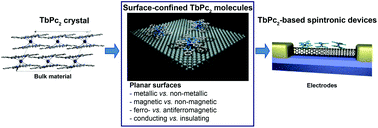Surface confinement of TbPc2-SMMs: structural, electronic and magnetic properties
Abstract
Since 2003, terbium(III) bis-phthalocyaninato complexes have been recognised as acting as single molecule magnets (SMMs), propitiating multiple studies with the aim of better understanding the single metal-ion based magnetism with unusually high blocking temperatures. In the quest for novel applications, it became clear that if spintronic devices were made from SMM molecules, their confinement in the proximity of surfaces or electrodes would become difficult to circumvent. In this perspective article, we highlight the influence of the presence of different substrates on the magnetic performance of TbPc2-SMMs, in principle caused by, among other effects, electronic hybridization, dipole–dipole coupling and changing quantum tunnelling (QT) rates on the surface. We show that the improved comprehension of how SMMs interact and communicate with the environment finally leads to magnetic remanence and lower tunnelling rates, paving the way to novel classes of spintronic devices.

- This article is part of the themed collection: Molecular Spintronics : The role of Coordination Chemistry


 Please wait while we load your content...
Please wait while we load your content...